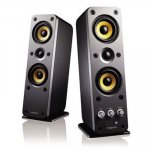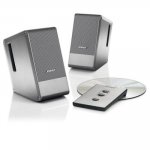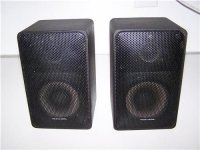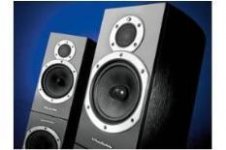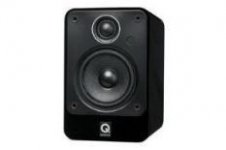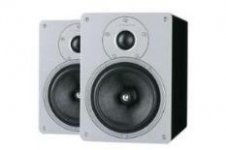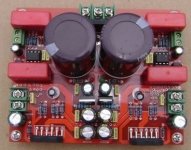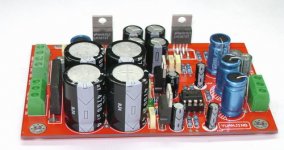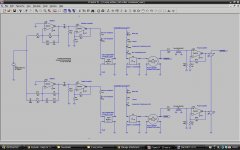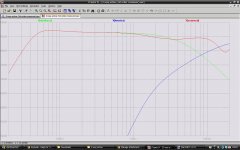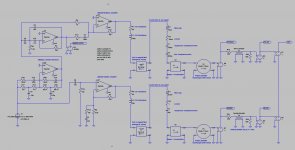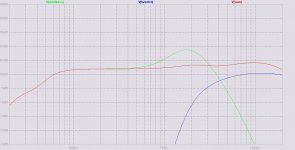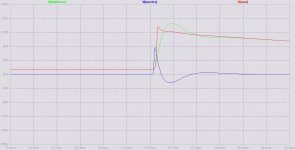Hi All ;
I am in need of some help. At last, I seem to have enough time to star building my self small active desktop monitors.
Here are my design goals :
1) Keep the total cost under 400 USD including everything.
2) Keep the size as small as possible,F3 of 70-80hz is more than adequate for me
I have vey basic knowledge on diy audio, and therefor need some help on making decisions.
Here are my questions :
(I am not after building the ultimate thing, as it's my first %100 diy project needs to be simple enough)
After reading a lot I decided
2-way setup wit a 4inch/4.5inch woofer + 1 inch tweeter
I will be using a LM1875T based stereo power amp to drive each unit.
An opamp based simple preamp
(I have 2x Integrated amp PCB's where 2x1875T is used with a NE5532, I will be glad if I can use those PCB's)
It's better for me to use line level passive filters (max 12db) as both active filters and passive speaker level filters are complex and will require too much time. And I think it won't be very hard to XO a small woofer to a decent tweeter using a 12db slope.
I will use an passive external box for input source switching.
Here are my questions :
1) Can I use line level filters between the source and line input of preamplifier?
2) Can I use the volume pot ( a stepped attunater) at the external passive line selector? It will be like :
Source --> Selector --> Volume pot -> Line Level Filter --> PreAMp--> Power Amp-->Driver
3) Torroidal transformers are not very expensive here. So will using 2x transformers for +/- supply rails bring me any advantage, or should I spare this money for better drivers?
4) Any recommendations about woofer/tweeter selection?
I prefer them to have similar sensivity. Max I want to pay is 140USD for 1xWoofer + 1xTweeter. (I prefer transparent sound with good imaging)
best regards
Mertol
I am in need of some help. At last, I seem to have enough time to star building my self small active desktop monitors.
Here are my design goals :
1) Keep the total cost under 400 USD including everything.
2) Keep the size as small as possible,F3 of 70-80hz is more than adequate for me
I have vey basic knowledge on diy audio, and therefor need some help on making decisions.
Here are my questions :
(I am not after building the ultimate thing, as it's my first %100 diy project needs to be simple enough)
After reading a lot I decided
2-way setup wit a 4inch/4.5inch woofer + 1 inch tweeter
I will be using a LM1875T based stereo power amp to drive each unit.
An opamp based simple preamp
(I have 2x Integrated amp PCB's where 2x1875T is used with a NE5532, I will be glad if I can use those PCB's)
It's better for me to use line level passive filters (max 12db) as both active filters and passive speaker level filters are complex and will require too much time. And I think it won't be very hard to XO a small woofer to a decent tweeter using a 12db slope.
I will use an passive external box for input source switching.
Here are my questions :
1) Can I use line level filters between the source and line input of preamplifier?
2) Can I use the volume pot ( a stepped attunater) at the external passive line selector? It will be like :
Source --> Selector --> Volume pot -> Line Level Filter --> PreAMp--> Power Amp-->Driver
3) Torroidal transformers are not very expensive here. So will using 2x transformers for +/- supply rails bring me any advantage, or should I spare this money for better drivers?
4) Any recommendations about woofer/tweeter selection?
I prefer them to have similar sensivity. Max I want to pay is 140USD for 1xWoofer + 1xTweeter. (I prefer transparent sound with good imaging)
best regards
Mertol
Checkout Procedures

It had to be funny... (LOL)When all the items you need have been added to your Shopping Cart, proceed to the Checkout counter.

This is probably not going to happen. 4" mid-base drivers tend to have lower sensitivity. True mid-range drivers have the sensitivity, but roll off at 400 Hz.I prefer them to have similar sensivity.
For 400 USD you can buy not one but two pairs of Creative Labs Gigaworks T40. Use one pair as reference, don't modify them. Carefully measure them using SpectraLabs 4.32. Open the second pair, reverse-engineer them (draw the schematic), modify them using better biamplification like your LM1875 amplifiers and better power supply, install a phase-accurate crossover, time-adjust the woofers with the tweeter, add a kevlar membrane high frequency notch, add a Linkwitz Transform for linearizing and extending the bass. Believe me, only this way you'll learn how to get good sound.It's better for me to use line level passive filters (max 12db) as both active filters and passive speaker level filters are complex and will require too much time. And I think it won't be very hard to XO a small woofer to a decent tweeter using a 12db slope. I will use an passive external box for input source switching.
Don't undervaluate the benefits of carefully measuring the "untouched" Creative Labs Gigaworks T40. Pay attention to this. Determine where there is room for improvement, on an objective basis.
Attachments
Last edited:
I think reverse engineering and carefully measuring T40's abilities is not the correct route for me. And T40's are more expensive in this part of the world due to some tax's.
My integrated amp boards are on the way to home right now, and I will appreciate if anyone can help me on driver selection.
br
Mertol
My integrated amp boards are on the way to home right now, and I will appreciate if anyone can help me on driver selection.
br
Mertol
1+2+3 indicate that your intellectual openness and commitment are on the thin side for such a project. Do you know the differences between closed box, closed box with passive radiator, and bass-reflex ? Are you fluent in using LTspiceIV for drawing schematics and simulating crossovers ? What measurement gear are you using; are you fluent with SpectraLab 4.32 ?1- It's better for me to use line level passive filters (max 12db) as both active filters and passive speaker level filters are complex and will require too much time.
2- I think it won't be very hard to XO a small woofer to a decent tweeter using a 12db slope.
3- Any recommendations about woofer/tweeter selection ? I prefer them to have similar sensivity.
Are you aware that a frequency response like Butterworth with a 70-80Hz -3dB frequency corner is going to subjectively translate into a dry, dull sound ? Is there a subwoofer available ?F3 of 70-80hz is more than adequate for me.
If you want to get some productive advice, you need to post the schematic of those PCB's.I have 2x Integrated amp PCB's where 2x1875T is used with a NE5532.
Why building from scratch ? Buy a pair of Realistic Minimus-7, add some equalization in your LM1875T-based amplifiers, and you are done. This is a closed-box design, easy to equalize in the bass using a Linkwitz Transform circuitry.
See here : REALISTIC MINIMUS-7 SPEAKERS MADE IN JAPAN GREAT SOUND | eBay
Later on you may bi-wire them.
This way you can use an external crossover like a 4th-order Linkwitz-Riley, with an impedance compensator for the woofer and a RLC notch (-8 dB at 4kHz) for the woofer.
This way you also can apply biamplification, introducing an active crossover.
See here : REALISTIC MINIMUS-7 SPEAKERS MADE IN JAPAN GREAT SOUND | eBay
Later on you may bi-wire them.
This way you can use an external crossover like a 4th-order Linkwitz-Riley, with an impedance compensator for the woofer and a RLC notch (-8 dB at 4kHz) for the woofer.
This way you also can apply biamplification, introducing an active crossover.
Attachments
Last edited:
Hi Mertol,My integrated amp boards are on the way to home right now, and I will appreciate if anyone can help me on driver selection.
Sorry for the joke. I think you need to be a little more assertive. So you don't want to buy a new pair of speakers but the drivers individually.
Just to say, for the sake of information for others, that good drivers/speakers in that/good price point are a hand full.
Wharfedale Diamond 10.1 http://www.stereophile.com/content/wharfedale-diamond-101-loudspeaker
Q Acoustics 2010
Cambridge Audio S30
Now you know what to expect, approximately.

So, what brands or shops you have access to in Turkey/others if you know, or you just ask from any in Europe/Germany/others? Do you want also to buy kits or not, for/if the price of the kit sent to you being a good one.
There are good brand names like Visaton, Seas, others, what are you into? or that is not so important.
Into the design, we, here in diyAudio, have been doing a different 2-Way with a full-range and woofer with very good results, or do you prefer a standard tweeter? Others will help with the electronics, because I only work with passives, but I think the questions I ask you, because of locations for delivery and taxes are of no less importance for you. Regards
Fully agree. Those speakers represent excellent value for the money. If their built-in passive crossover are not ill-designed, adding a dedicated amplifier embedding a Linkwitz Transform and some careful medium/high equalization should result in a pretty good listening experience at moderate listening levels, obviating the need for a subwoofer. Would be nice to start three distinct threads, each about one of the above speaker, carefully measuring them, reverse-engineering them, and proposing various upgrade paths like : 1) designing a Linkwitz Transform for linearizing and extending the deep bass, 2) bi-wiring them for allowing an external crossover, 3) designing a 4th-order Linkwitz-Riley passive crossover with the woofer impedance corrector, the woofer hi-freq RLC damping, and the tweeter time alignment, 4) designing the corresponding 4th-order Linkwitz-Riley active crossover and twin power amp.Just to say, for the sake of information for others, that good drivers/speakers in that/good price point are a hand full.
Wharfedale Diamond 10.1
Q Acoustics 2010
Cambridge Audio S30
Attachments
Last edited:
Thanks for so many posts. I will try to adres most of the questions.
1) I think I am intellectually open and however I evaluated some of the choices against a few other parameters (like time I want to dedicate, my limited skill set) so I wanted to start with a set of fixed parameters to limit the suggestions. Otherwise everybody has a favorite set up and would like to push it and it will be impossible for me to get the missing information for me to complete the project from the community.
2) about the dullness of the song with -3 db cut off at 70-80hz, I partially agree and having been using NS1000Ms for the last 10 years or so with a few other speakers, I'd prefer to go down to 40-50hz but those will be used at my work desk and need to keep the sie limited. I have a sub , but I honestly don't think that I will attach it. So at the end of the day 70-80hz f3 is ok for me
3)Schematics: I don't have them as I ordered the boards from ebay. However here are the links, perhaps close up shots may give more information. PS: Don't expect anything hi-end.
http://www.ebay.com/itm/19058734932...X:IT&_trksid=p3984.m1439.l2649#ht_4449wt_1069
eBay - New & used electronics, cars, apparel, collectibles, sporting goods & more at low prices
As the priced seem to be OK, I also ordered 2x LM3886 boards.
I know I may need to modify them a little bit for a better impedance characteristics to better align with the passive line level filter.
4) It's a good idea to buy a speaker and modify it however and it would be quicker and easier. However due to severe government taxes speaker prices are quite high in here. i.e. wharfdale 10.2 is 400USD ( 10.1's are not imported for some reason) I have mission 780's (using them for surround somewhere) nut I think that putting an amplifier inside will eat up too much internal space and can eat up from the already weak bass response (I know I can equalize for the loss) At the end of the day, I like the wood working part and I'd like the give my self a chance
5) About what speakers available to me. (very good question) I can buy from ebay.de and ebay.co.uk (ebay.com is possible but shipments are a lot higher) and I can buy from europe-audio.com (I don't prefer speaker kits with the wood as they are heavy)
I hope that I addressed the questions. So back to initial questions. As I already purchased the amplifiers (probably more than I needed) , I am in need of selecting the speakers. As I bought the LM3886's which can deliver more watts than 1875T's efficieny is not much of a problem. Here are my criteria's
1) Ease of mounting. As I will be flash mounting I prefer round shapes, as I don't have an idea on how to flash mount strangely shaped drivers. I do have a router but never used it for recessing drivers. I will order a rabbeting bit (hope I wrote it correct)
2) I prefer smilar sensivity so that XO would be simpler
3) Should be compatible with 1 st or 2 nd order XO , so I can go with passive and live happily. If it doesn't work I promise to give active XO's a try.
4) Woofer + tweeter should cost around 150 USD + shipment at most. But if you tell that audio nirvana can be reached at 160 USD only, I'd say why not?
Thanks a lot , I already learned a lot.
best regards
Mertol
1) I think I am intellectually open and however I evaluated some of the choices against a few other parameters (like time I want to dedicate, my limited skill set) so I wanted to start with a set of fixed parameters to limit the suggestions. Otherwise everybody has a favorite set up and would like to push it and it will be impossible for me to get the missing information for me to complete the project from the community.
2) about the dullness of the song with -3 db cut off at 70-80hz, I partially agree and having been using NS1000Ms for the last 10 years or so with a few other speakers, I'd prefer to go down to 40-50hz but those will be used at my work desk and need to keep the sie limited. I have a sub , but I honestly don't think that I will attach it. So at the end of the day 70-80hz f3 is ok for me
3)Schematics: I don't have them as I ordered the boards from ebay. However here are the links, perhaps close up shots may give more information. PS: Don't expect anything hi-end.
http://www.ebay.com/itm/19058734932...X:IT&_trksid=p3984.m1439.l2649#ht_4449wt_1069
eBay - New & used electronics, cars, apparel, collectibles, sporting goods & more at low prices
As the priced seem to be OK, I also ordered 2x LM3886 boards.
I know I may need to modify them a little bit for a better impedance characteristics to better align with the passive line level filter.
4) It's a good idea to buy a speaker and modify it however and it would be quicker and easier. However due to severe government taxes speaker prices are quite high in here. i.e. wharfdale 10.2 is 400USD ( 10.1's are not imported for some reason) I have mission 780's (using them for surround somewhere) nut I think that putting an amplifier inside will eat up too much internal space and can eat up from the already weak bass response (I know I can equalize for the loss) At the end of the day, I like the wood working part and I'd like the give my self a chance
5) About what speakers available to me. (very good question) I can buy from ebay.de and ebay.co.uk (ebay.com is possible but shipments are a lot higher) and I can buy from europe-audio.com (I don't prefer speaker kits with the wood as they are heavy)
I hope that I addressed the questions. So back to initial questions. As I already purchased the amplifiers (probably more than I needed) , I am in need of selecting the speakers. As I bought the LM3886's which can deliver more watts than 1875T's efficieny is not much of a problem. Here are my criteria's
1) Ease of mounting. As I will be flash mounting I prefer round shapes, as I don't have an idea on how to flash mount strangely shaped drivers. I do have a router but never used it for recessing drivers. I will order a rabbeting bit (hope I wrote it correct)
2) I prefer smilar sensivity so that XO would be simpler
3) Should be compatible with 1 st or 2 nd order XO , so I can go with passive and live happily. If it doesn't work I promise to give active XO's a try.
4) Woofer + tweeter should cost around 150 USD + shipment at most. But if you tell that audio nirvana can be reached at 160 USD only, I'd say why not?
Thanks a lot , I already learned a lot.
best regards
Mertol
You can change the feedback network of the LM1875 (or LM3886). For stability and distorsion reasons, you should not change their HF gain.I know I may need to modify them (the pre-assembled boards boards)a little bit for a better impedance characteristics to better align with the passive line level filter.
You can change the feedback network of the NE5532.
First thing to do is to connect the woofer and the tweeter without any board modification. You then modify the feedback network around the NE5532 section dealing with the tweeter, for adapting the signal amplitude delivered to the tweeter section, for getting the same SPL from the tweeter and the woofer. So easy !
This way you can select any kind of tweeter having any kind of sensitivity.
Second thing to do is to lowpass the woofer. Like you said you can try a 1st order lowpass. In such case you need a quality miniwoofer exhibiting no high frequency resonance.
Such quality miniwoofer can be :
Vifa 9 BG119/8 (Xmax 2.3 mm, price 29 eur) (ebay.de) Fiberglass. A classic ! You can't go wrong with it ! Should be first on your list.
Dynavox FR88EX (Xmax 3 mm, price 35 eur) (ebay.de) Aluminium. Nice little speaker, extremely wideband, this is the high-excursion version of an interesting family. Should be second on your list.
Visaton B80 (Xmax 2.2 mm, price 62 eur) (ebay.de) A new challenger, quite overpriced at the moment.
Morel CAW 428 (Xmax 4 mm, price 73 eur maybe)
Peerless HDS PPB 4-25/08 (Xmax 3 mm, price 57 eur maybe)
Seas Prestige CA12RCY H1152 (Xmax 3 mm, price 59 eur maybe)
Wavecor WF110WA02/04 (Xmax 3 mm, price 40 eur maybe)
The Tang Band W4-657 (Xmax 3mm, price 35 eur) (eBay.de) cannot be used in a simple 1st order crossover because it peaks at +10dB around 7kHz. The Tang Band W4-657 requires thus a passive RLC notch filter after the output of the power amplifier, tuned at 7kHz.
The Dynavox DY-103 (4 eur on eBay.de) cannot be used in a simple 1st order crossover because it peaks at +8dB around 8kHz.
The Dynavox DY-131 (5 eur on eBay.de) cannot be used in a simple 1st order crossover because it peaks at +9dB around 6kHz.
The Dynavox DY-161 (6 eur on eBay.de) cannot be used in a simple 1st order crossover because it peaks at +10dB around 4.5kHz.
Those are three good loudspeakers, their membrane is made of paper with a polypropylene coating, enabling a smooth roll-off after the resonance, without secondary resonances. Cone breakup is indeed very well controlled. I thus recommend those speakers. All what is needed, is a passive RLC notch filter after the output of the power amplifier, tuned at 8kHz, 6 kHz or 4.5 kHz.
How to 1st-order lowpass the miniwoofer ? You need to wire the NE5532 bass section as an unity gain inverting amp (may need some chirurgy on the PCB), putting a RC network in the feedback. Use a 10k resistor as series input resistor. Use a 10k resistor as feedback. This way you get a unity inverting amp. Add a 4.7nF capacitor in parallel with the feedback resistor, and now you get a 1st-order lowpass at 3.4 kHz. Provided you are using a quality miniwoofer, you are now done with the bass section.
Let us now determine the tweeter section. Let us realize the context first. You definitively know that you are dealing with a miniwoofer having a relatively small Xmax. Therefore you definitively know that if your music is containing deep bass, listening it at a high volume, the miniwoofer will saturate. You thus know that you need to listen at moderate SPL.
A surprisingly good & still inexpensive tweeter is the Visaton CP13 (price 13 eur on eBay.de), especially when passive high-pass filtered with a 2.2µF capacitor in series. I urge you to test it. Such is my recommendation.
Considering your cost budget, you may use not one miniwoofer, but two miniwoofers in a d'Appolito configuration with minimal distance between the two miniwoofers. Only the Visaton CP13 allows you a minimal distance between the two miniwoofers. You'll get a smooth symetric radiation pattern, and an improved max SPL in the deep bass.
I guess that you are aware that when using a 1st-order crossover, the miniwoofer and the tweeter are working together at -3dB with a 90 degree relative phase shift in the transition band. As consequence, with a 1st-order crossover, if you are not using the d'Appolito arrangement, the radiation pattern will be pathologic. So you see, there is no free lunch : if you want to keep the crossover as simple as possible (1st-order), you need two miniwoofers in a d'Appolito arrangement for avoiding the pathologic radiation pattern.
In order to encourage you using a 1st-order crossover with a d'Appolito arrangement, may I remember you that you'll get a perfectly reconstructed phase ? This is far better than any other crossover. Even reputated crossovers like the Linkwitz-Riley 4th-order introduce a massive phase distorsion. In contrast, your system built around a 1st-order crossover and d'Appolito arrangement, will exhibit no phase distorsion, assorted with a smooth radiation pattern. Remember you need to keep minimal the distance between the two minowoofers. Remember you need to time-aligning the woofers with the tweeter.
Now you realize that all you need for passively filtering the tweeter, is a good quality 2.2µF capacitor, non polarized.
Using a Visaton CP13 with a 2.2µF capacitor in series, you get a -3dB frequency not equal to 3.5 kHz, but equal to 5 kHz roughly. You need a 5 kHz frequency corner in the NE5532 lowpass section. In the NE5532 lowpass section (see above), instead of using a 4.7nF capacitor (see above), use a 2.7nF or a 3.3nF capacitor.
If you don't like the idea of a passive filter for the tweeter, you may use the NE5532 -> poweramp interface as highpass. Change the input resistor of the poweramp and make it equal to 2.2k. Change the coupling capacitor between the NE5532 and the poweramp and make it equal to 15nF. You now have a 1st-order highpass operating at 5 kHz roughly. You can now DC-couple the tweeter to the poweramp.
If you like wood working, I advise you to time-align the tweeter emission center with the miniwoofer emission center. This is easy done by mounting the minifoofers on a raised baseplate. Avoid abrupt angles that may cause diffraction, especially near the tweeter.It's a good idea to buy a speaker and modify it however and it would be quicker and easier... At the end of the day, I like the wood working part and I'd like the give my self a chance.
Your choice is thus quite large.About what speakers available to me, I can buy from ebay.de, ebay.co.uk from europe-audio.com. I don't prefer speaker kits with the wood as they are heavy.
You are wrong here. See above how you compensate different sensitivities using the on-board NE5532.I prefer smilar sensivity so that XO would be simpler.
Indeed, opting for a 1st order crossover is a wise choice. See above how to implement it properly.Should be compatible with 1 st or 2 nd order XO, so I can go with passive and live happily. If it doesn't work I promise to give active XO's a try.
I let you do the calculations. Is it 150 USD for a stereo system ?Woofer + tweeter should cost around 150 USD + shipment at most. But if you tell that audio nirvana can be reached at 160 USD only, I'd say why not?
But .... wait a minute .... are you going to build a closed box, or a bass-reflex box ? If you liked the Yamaha NS1000 sound, surely you will prefear buiding a closed box.
You need to use a speaker design software, enter the Thiele-Small parameters, and determine the inner volume of your closed box for attaining a Bessel or a Butterworth alignment. If you are using two miniwoofers in a d'Appolito arrangement, the volume needs to be multiplied by two.
The resulting sound will be smooth, precise, but dull and not enveloping. The sound will lack bass extension. You will need to measure your system using SpectraLab 4.32, and print the amplitude curve between 20 Hz and 1000 Hz. You will need to design a Linkwitz Transform targeting a Bessel alignement (Q=0.5) with a reasonable specification like 45 Hz at -3dB. Such Linkwitz Transform may be built using a breadboard, a NE5532 and a few resistors and capacitors. Nothing to worry.
Attachments
Last edited:
Thanks for the excellent detailed response.
I think I can spare 150-160 USD for 1xWoofer + 1xTweeter.
Now it's my time to do some homework and narrow down the list. I am aware of the benefits of d'Appolito setup and I will evaluate this as the primary option. (need to calculate the box size to see if it's gonna end up with reasonable size)
Your ideas about embedding the XO inside the feedback loop and between the pre-amp and power amp looks easy to implement and measure.
I have more questions, but it's better to focus on the next step and chose the drivers. I think the amps will arrive in 3-4 days and it will take me 2 days to get the transformers ready.
If I can order the drivers this week, I can start building the box very soon.
So in short term I need advices on how to recess drivers that have odd shape (i.e. not round)
Can someone help me on this topic?
best regards
Mertol
I think I can spare 150-160 USD for 1xWoofer + 1xTweeter.
Now it's my time to do some homework and narrow down the list. I am aware of the benefits of d'Appolito setup and I will evaluate this as the primary option. (need to calculate the box size to see if it's gonna end up with reasonable size)
Your ideas about embedding the XO inside the feedback loop and between the pre-amp and power amp looks easy to implement and measure.
I have more questions, but it's better to focus on the next step and chose the drivers. I think the amps will arrive in 3-4 days and it will take me 2 days to get the transformers ready.
If I can order the drivers this week, I can start building the box very soon.
So in short term I need advices on how to recess drivers that have odd shape (i.e. not round)
Can someone help me on this topic?
best regards
Mertol
Read the link. It is a well documented and thouroughly explored setup that is built with very well regarded components. You would be hard pressed to beat it and will have to do little in the way of your own research. It should best anything listed in my opinion and you will have capable components for future builds.
I did read it indeed, and it looks like a very well thought set up and probably a lot better than what I am going to achieve... However I already have a decent home setup (NS1000M's connected to Pioneer Exclusive M5a's connected to Sony CDP-R1 DAS-R1) and the idea of the project is not to reach audio nirvana, just to build something decent for my desktop and educate me on the way and sharpen my engineering and problem solving skills.
While I am very open to learning from other setup's, I am not afraid to add a few things of my own and fail, if necessary. So please help me design something of my own, rather than than copy a design, not because the design you suggested is inferior but basically it's not the way I want to go (the 7 incher is to big, I already own a Jamo concert 8's etc, which is a quite smilar design btw)
br
Mertol
While I am very open to learning from other setup's, I am not afraid to add a few things of my own and fail, if necessary. So please help me design something of my own, rather than than copy a design, not because the design you suggested is inferior but basically it's not the way I want to go (the 7 incher is to big, I already own a Jamo concert 8's etc, which is a quite smilar design btw)
br
Mertol
I recently built a simple 2-way.
Dayton DC28-f 1-1/8" Silk Dome
Dayton RS100-8 4" Full Range Driver
5k 1st order butterworth.
3db L-Pad on tweeter.
.25 cuft slot vented box.
Box tuned to 69hz.
For standard listening they sound great.
For high volume they need a sub but if volume is reasonable you will not encounter any distortion.
Your LM1875 amps shouldn't put out enough power to make them distort.
I am driving the pair with an LM4780 and I love them.
3/4" MDF construction, 6"w*9"d*13"h.
At first I built the speaker without a tweeter and they sounded great.
I now know that they would need a tank circuit to eliminate the 16k +9db spike.
With that circuit to eliminate the spike I would probably be happy with the 4" in full range.
If you can deal with a 4ohm load the RS100-4 only needs .125 cuft.
In this simple configuration you will have descent extension to 65hz and a simple small box with minimal crossover.
Dayton DC28-f 1-1/8" Silk Dome
Dayton RS100-8 4" Full Range Driver
5k 1st order butterworth.
3db L-Pad on tweeter.
.25 cuft slot vented box.
Box tuned to 69hz.
For standard listening they sound great.
For high volume they need a sub but if volume is reasonable you will not encounter any distortion.
Your LM1875 amps shouldn't put out enough power to make them distort.
I am driving the pair with an LM4780 and I love them.
3/4" MDF construction, 6"w*9"d*13"h.
At first I built the speaker without a tweeter and they sounded great.
I now know that they would need a tank circuit to eliminate the 16k +9db spike.
With that circuit to eliminate the spike I would probably be happy with the 4" in full range.
If you can deal with a 4ohm load the RS100-4 only needs .125 cuft.
In this simple configuration you will have descent extension to 65hz and a simple small box with minimal crossover.
Schematics and simulation using LTspiceIV. See attached .zip.
This is a 1st-order "acoustic" crossover with time alignment.
The miniwoofer and the tweeter have been individually precompensated for delivering true 1st-order acoustic responses near the crossover frequency.
The tweeter gets delayed by 45 µs (15 mm mechanically pushed into the box relative to the miniwoofer emission center) for achieving a zero phase shift crossover arrangement. Proof of this is the crossing now occuring at -6dB instead of -3dB.
The woofer -3dB high frequency is 4.2 kHz, a frequency any decent miniwoofer can handle with precision. Miniwoofers exhibit no pronounced directivity yet at 4.2 kHz.
The red curve is the resulting SPL curve when vector summing the miniwoofer acoustic response and the tweeter acoustic response.
The resulting curve is essentially flat from 200 Hz to 10 kHz, fitting into a 3dB corridor.
When the red curve sits below one of the two other curves, the two transducers are working in phase opposition.
We identify such a problematic situation between 900 Hz and 3500 Hz, the effect stays however minimal with less than 1 dB loss because at such frequencies, the tweeter contribution is minimal, 20 dB down the miniwoofer.
We identify such a problematic situation above 13 kHz. In reality, most miniwoofers get completely extinguished at such high frequency. Above 13 kHz, most woofers can't thus counteract the acoustic energy emitted by the tweeter. This may not be true for miniwoofers equipped with an aluminium membrane radiating considerable energy as high as 20 kHz, however concentrated in the acoustic axis.
This is a 1st-order "acoustic" crossover with time alignment.
The miniwoofer and the tweeter have been individually precompensated for delivering true 1st-order acoustic responses near the crossover frequency.
The tweeter gets delayed by 45 µs (15 mm mechanically pushed into the box relative to the miniwoofer emission center) for achieving a zero phase shift crossover arrangement. Proof of this is the crossing now occuring at -6dB instead of -3dB.
The woofer -3dB high frequency is 4.2 kHz, a frequency any decent miniwoofer can handle with precision. Miniwoofers exhibit no pronounced directivity yet at 4.2 kHz.
The red curve is the resulting SPL curve when vector summing the miniwoofer acoustic response and the tweeter acoustic response.
The resulting curve is essentially flat from 200 Hz to 10 kHz, fitting into a 3dB corridor.
When the red curve sits below one of the two other curves, the two transducers are working in phase opposition.
We identify such a problematic situation between 900 Hz and 3500 Hz, the effect stays however minimal with less than 1 dB loss because at such frequencies, the tweeter contribution is minimal, 20 dB down the miniwoofer.
We identify such a problematic situation above 13 kHz. In reality, most miniwoofers get completely extinguished at such high frequency. Above 13 kHz, most woofers can't thus counteract the acoustic energy emitted by the tweeter. This may not be true for miniwoofers equipped with an aluminium membrane radiating considerable energy as high as 20 kHz, however concentrated in the acoustic axis.
Attachments
Schematics and simulation using LTspiceIV.
Comparison between in-phase tweeter and inverted tweeter.
See attached .zip.
Comparison between in-phase tweeter and inverted tweeter.
See attached .zip.
Attachments
-
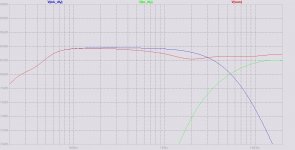 1st order crossover - in phase tweeter (gain).jpg87.9 KB · Views: 51
1st order crossover - in phase tweeter (gain).jpg87.9 KB · Views: 51 -
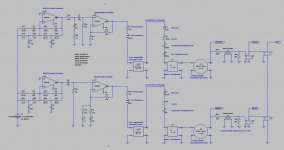 1st order crossover - in phase tweeter (schema).jpg73.1 KB · Views: 300
1st order crossover - in phase tweeter (schema).jpg73.1 KB · Views: 300 -
2-way active (1st order crossover).zip261.2 KB · Views: 31
-
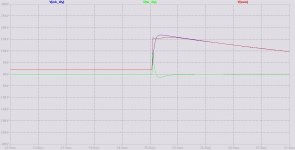 1st order crossover - in phase tweeter (step response).jpg70.6 KB · Views: 29
1st order crossover - in phase tweeter (step response).jpg70.6 KB · Views: 29 -
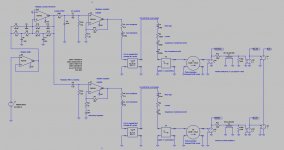 1st order crossover - inverted tweeter (schema).jpg71.4 KB · Views: 50
1st order crossover - inverted tweeter (schema).jpg71.4 KB · Views: 50 -
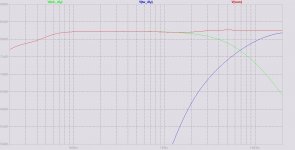 1st order crossover - inverted tweeter (gain).jpg82.1 KB · Views: 43
1st order crossover - inverted tweeter (gain).jpg82.1 KB · Views: 43 -
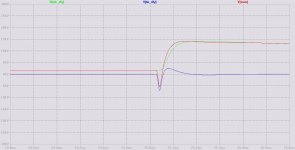 1st order crossover - inverted tweeter (step response).jpg74.9 KB · Views: 27
1st order crossover - inverted tweeter (step response).jpg74.9 KB · Views: 27
Last edited:
Schematics and simulation using LTspiceIV, substractive filter approach.
An electronic copy of the tweeter acoustic response (as measured without any crossover) is elaborated using one opamp configured as 2nd order Rauch highpass filter.
In this 1st order application, the tweeter only gets 1st order highpass filtered using a RC network (10K ohm, 12nF) at the input of the tweeter poweramp.
The resulting acoustic response of the filtered tweeter can thus be simulated using the 2nd order Rauch highpass filter followed by a filter equivalent to the above 1st order high pass (now 1K ohm, 120 nF).
The Rauch filter is inverting, with an amplification coeffcient equal to -1.
The minibass signal gets elaborated by computing the difference between the input signal, and the simulated acoustic response of the filtered tweeter. This automatically happens thanks to the two 1K ohm resistors connecting to the inverting input of the minibass poweramp.
As the minibass is adding its own phase (modelled here as 1st order lowpass because of the coil inductance), and as this effect has not being taken into account yet, some moderate delay is actually needed in the tweeter (22 µs, equivalent to a 7 mm recession).
For sure, the minibass lowpass model lacks precision above 5 kHz or so. Expect needing a different delay for setting to 90 degree the relative phase shift between the minibass and the tweeter, in the crossover overlap band. Play with the delay. If this doesnt work, try slighly detuning the tweeter model (through the Rauch filter and the 1st order highpass that's following). Last resource is to lower the crossover frequency, where the minibass doesn't yet exhibit a significant deviation with the coil inductance model. Change the above 120nF and 12nF capacitors by 180nF and 18nF capacitors.
For protecting the tweeter against low frequencies, the Linkwitz Transform is only applied to the minibass signal path. Such Linkwitz Transform introduces a 180 degree phase shift. Fortunately, the minibass power amp is an inverting amp. The minibass signal phase gets thus restored, there is no need to invert the wiring of the minibass.
This kind of crossover is only manageable after having carefully measured the minibass and the tweeter using a software like SpectraLab 4.32.
LTspiceIV is essential for defining the components values inside the Rauch highpass filter, for making sure that the unfiltered tweeter acoustic response gets accurately simulated. This is the aim of the signal output labelled "tweeter simul".
I especially appreciate such substractive filter.
The tweeter gets a healthy uncomplicated 1st order highpass. The tweeter phase response gets thus minimally disturbed, only 90 degree at the max.
All what is asked to the minibass is to complement the tweeter acoustic response. A minibass can do this at the condition that is stays operating in its "controlled" operating range, at a frequency lower than the cone breakup frequency, and at a frequency where the minibass coil inductance only adds a few tens of degrees as phase lag. If the crossover is 3.5 kHz, the minibass needs to behave somoothly untill 7.0 kHz or so, without peaks in the acoustic response.
Expensive speakers designed for a "full-range" use won't behave well in such substactive crossover because in general "full range" speakers rely on some weird cone resonances for delivering sound above 8 kHz. On top of this, most "full-range" speakers don't provide the required excursion (Xmax) for operating as midbass in a closed box. There are less pricey minibass speakers on the market, small diameter like 3 or 4 inch, delivering a smooth frequency and phase response untill 8 kHz or so, with an Xmax of 3 mm or so. Remember there is a possibility in compensating the unavoidable minibass phase lag in the transition band, by time-aligning the tweeter, recessing the tweeter by one centimeter or so.
For the tweeter, I recommend the Visaton CP13 as a start point. The Visaton CP13 delivers nice smooth delicate highs when filtered at 3.5 kHz or above. The 13 mm diameter enables a precise d'Appolito setup with minimal distance between the two minibass, a crucial design parameter.
An electronic copy of the tweeter acoustic response (as measured without any crossover) is elaborated using one opamp configured as 2nd order Rauch highpass filter.
In this 1st order application, the tweeter only gets 1st order highpass filtered using a RC network (10K ohm, 12nF) at the input of the tweeter poweramp.
The resulting acoustic response of the filtered tweeter can thus be simulated using the 2nd order Rauch highpass filter followed by a filter equivalent to the above 1st order high pass (now 1K ohm, 120 nF).
The Rauch filter is inverting, with an amplification coeffcient equal to -1.
The minibass signal gets elaborated by computing the difference between the input signal, and the simulated acoustic response of the filtered tweeter. This automatically happens thanks to the two 1K ohm resistors connecting to the inverting input of the minibass poweramp.
As the minibass is adding its own phase (modelled here as 1st order lowpass because of the coil inductance), and as this effect has not being taken into account yet, some moderate delay is actually needed in the tweeter (22 µs, equivalent to a 7 mm recession).
For sure, the minibass lowpass model lacks precision above 5 kHz or so. Expect needing a different delay for setting to 90 degree the relative phase shift between the minibass and the tweeter, in the crossover overlap band. Play with the delay. If this doesnt work, try slighly detuning the tweeter model (through the Rauch filter and the 1st order highpass that's following). Last resource is to lower the crossover frequency, where the minibass doesn't yet exhibit a significant deviation with the coil inductance model. Change the above 120nF and 12nF capacitors by 180nF and 18nF capacitors.
For protecting the tweeter against low frequencies, the Linkwitz Transform is only applied to the minibass signal path. Such Linkwitz Transform introduces a 180 degree phase shift. Fortunately, the minibass power amp is an inverting amp. The minibass signal phase gets thus restored, there is no need to invert the wiring of the minibass.
This kind of crossover is only manageable after having carefully measured the minibass and the tweeter using a software like SpectraLab 4.32.
LTspiceIV is essential for defining the components values inside the Rauch highpass filter, for making sure that the unfiltered tweeter acoustic response gets accurately simulated. This is the aim of the signal output labelled "tweeter simul".
I especially appreciate such substractive filter.
The tweeter gets a healthy uncomplicated 1st order highpass. The tweeter phase response gets thus minimally disturbed, only 90 degree at the max.
All what is asked to the minibass is to complement the tweeter acoustic response. A minibass can do this at the condition that is stays operating in its "controlled" operating range, at a frequency lower than the cone breakup frequency, and at a frequency where the minibass coil inductance only adds a few tens of degrees as phase lag. If the crossover is 3.5 kHz, the minibass needs to behave somoothly untill 7.0 kHz or so, without peaks in the acoustic response.
Expensive speakers designed for a "full-range" use won't behave well in such substactive crossover because in general "full range" speakers rely on some weird cone resonances for delivering sound above 8 kHz. On top of this, most "full-range" speakers don't provide the required excursion (Xmax) for operating as midbass in a closed box. There are less pricey minibass speakers on the market, small diameter like 3 or 4 inch, delivering a smooth frequency and phase response untill 8 kHz or so, with an Xmax of 3 mm or so. Remember there is a possibility in compensating the unavoidable minibass phase lag in the transition band, by time-aligning the tweeter, recessing the tweeter by one centimeter or so.
For the tweeter, I recommend the Visaton CP13 as a start point. The Visaton CP13 delivers nice smooth delicate highs when filtered at 3.5 kHz or above. The 13 mm diameter enables a precise d'Appolito setup with minimal distance between the two minibass, a crucial design parameter.
Attachments
Last edited:
- Status
- This old topic is closed. If you want to reopen this topic, contact a moderator using the "Report Post" button.
- Home
- Loudspeakers
- Multi-Way
- Need Advice on designing a budget active speaker
